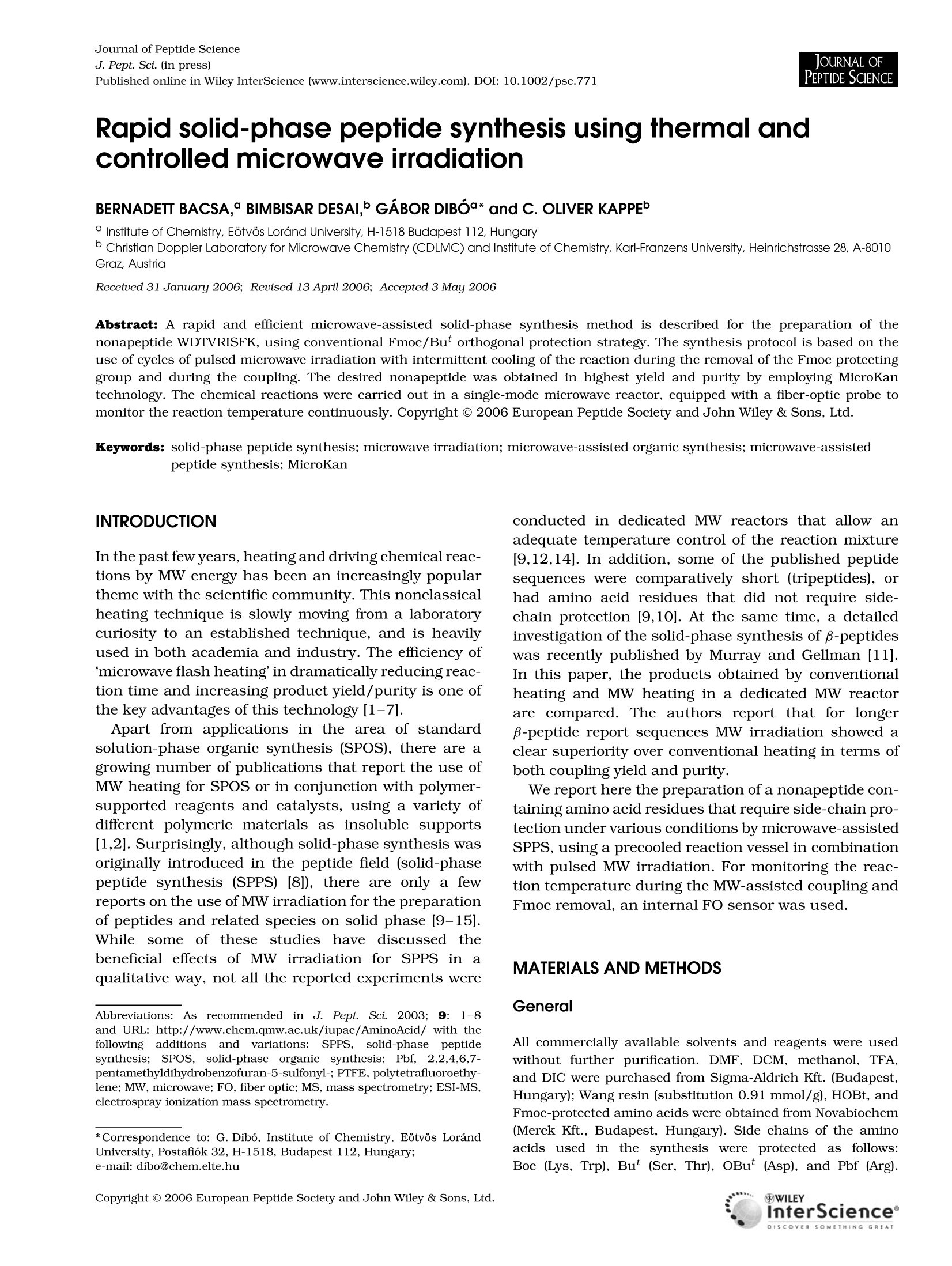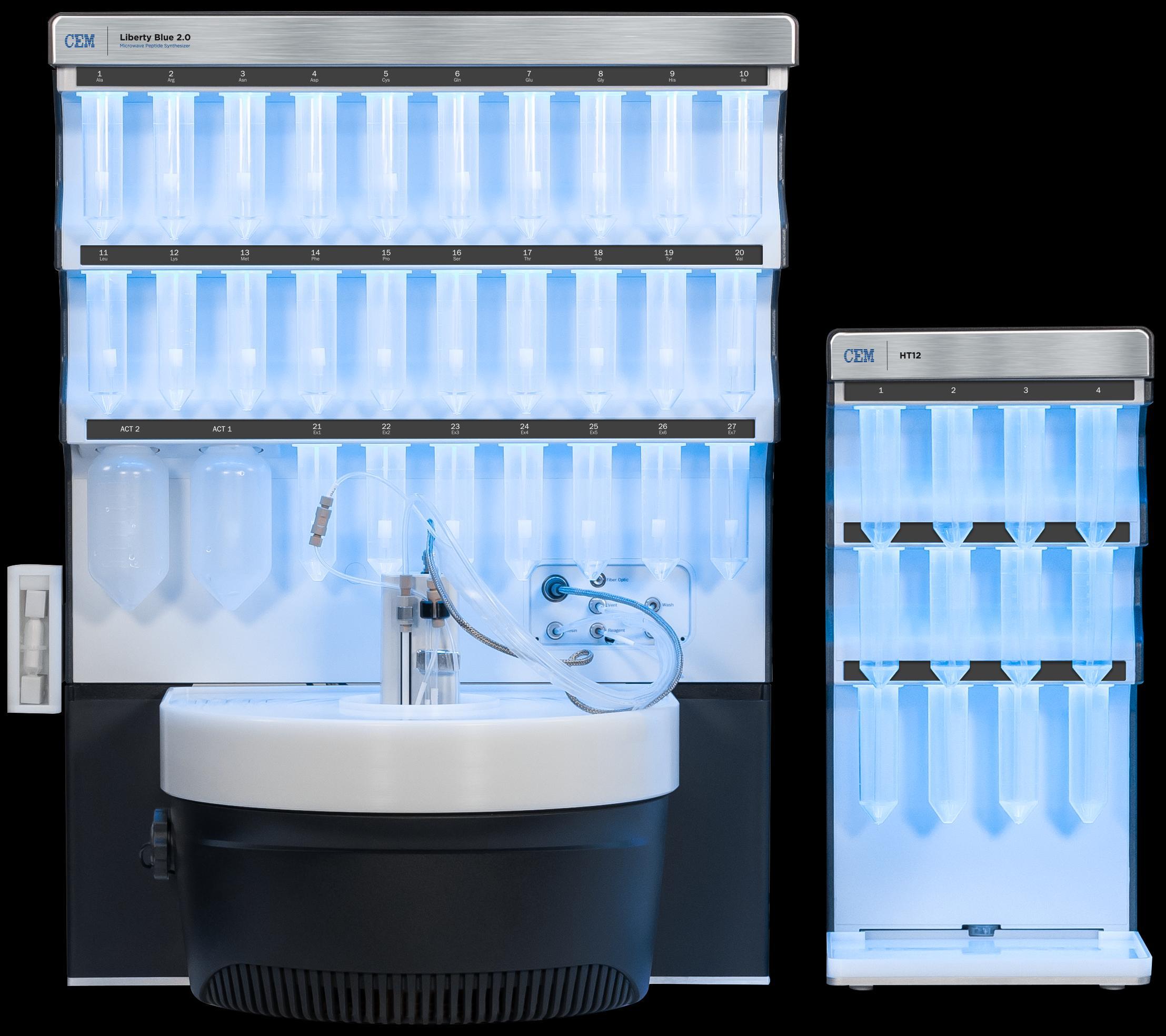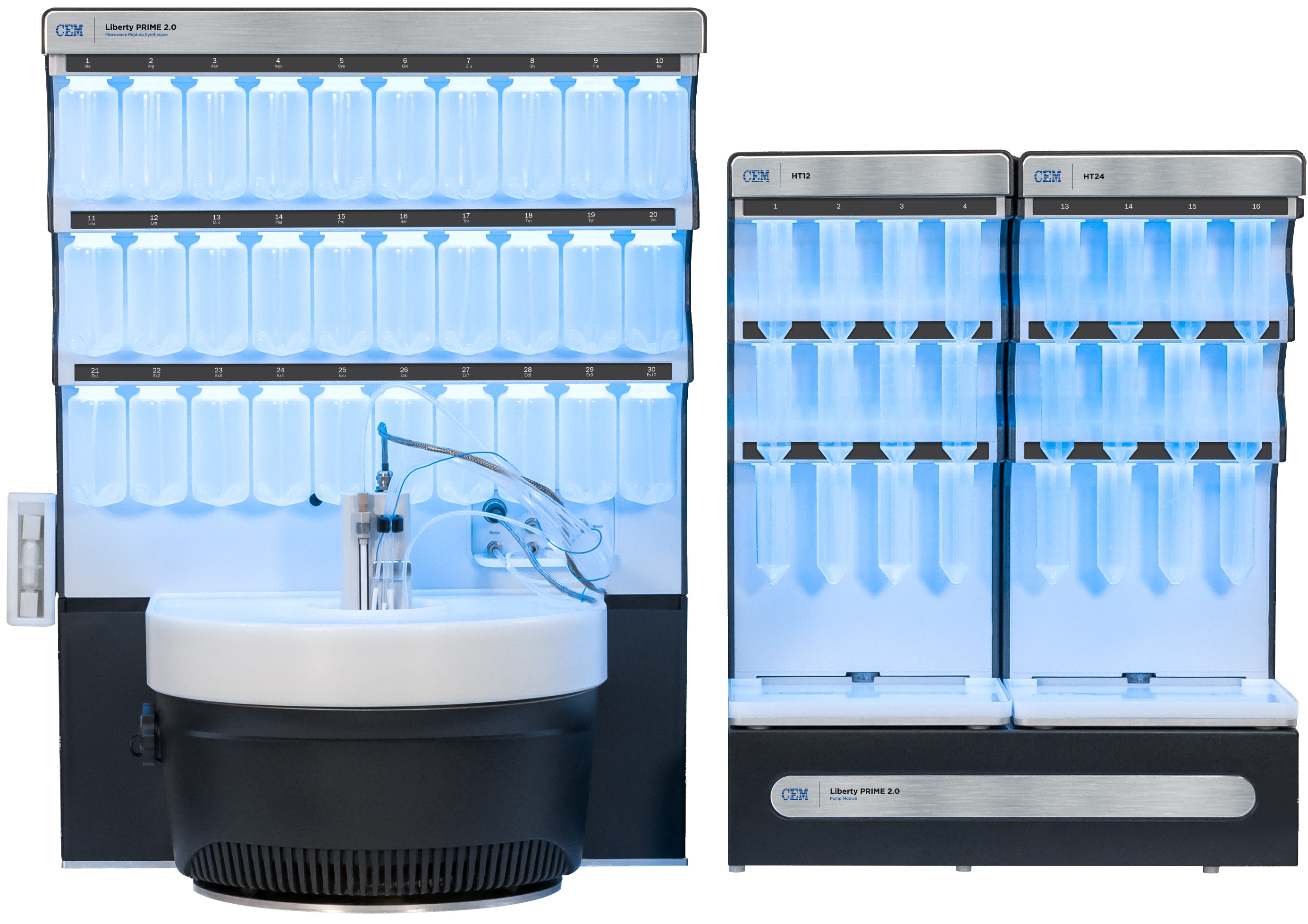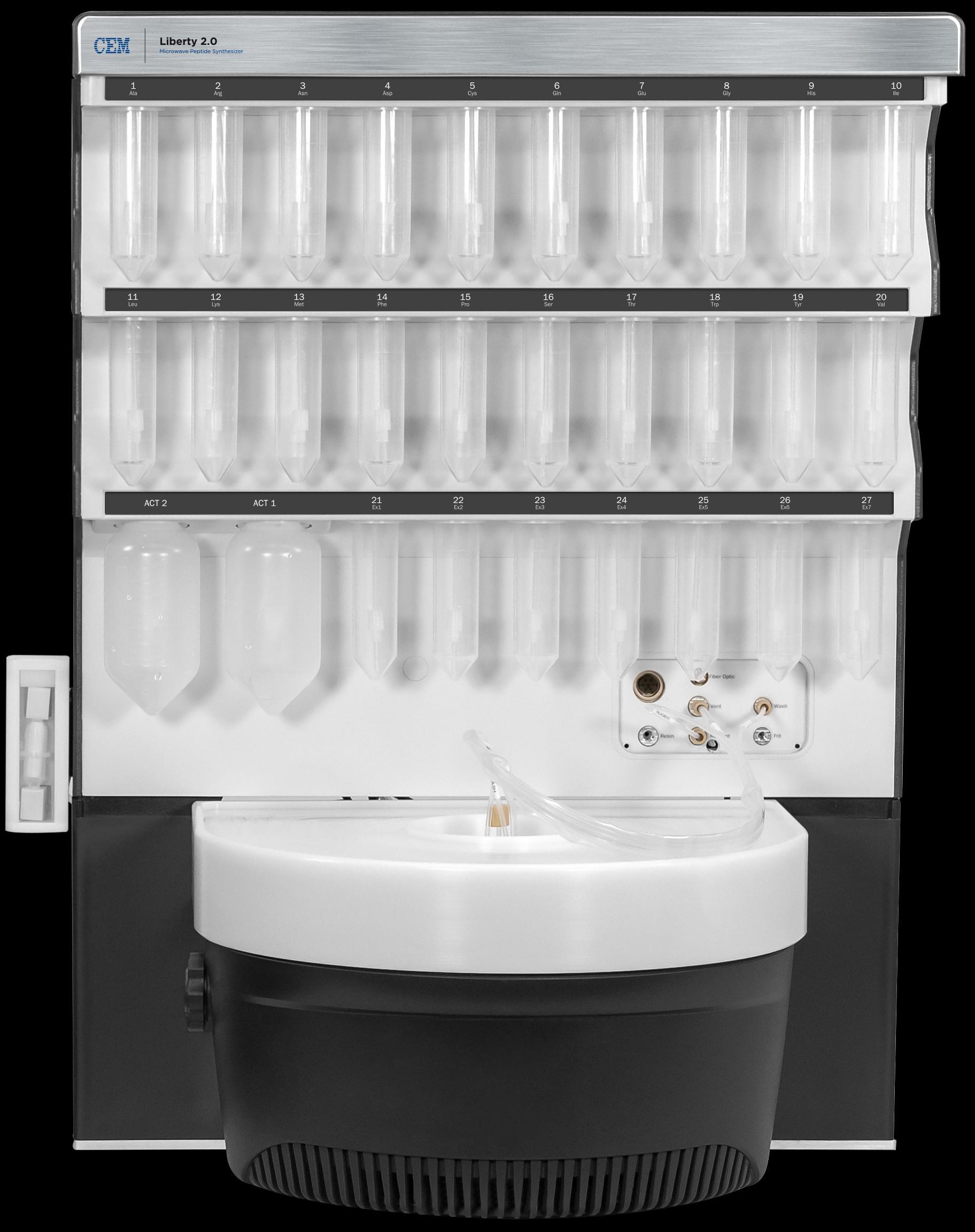方案详情文
智能文字提取功能测试中
Journal of Peptide ScienceJ. Pept. Sci. (in press)Published online in Wiley InterScience (www.interscience.wiley.com). DOI: 10.1002/psc.771 BACSA ETAL. Rapid solid-phase peptide synthesis using thermal andcontrolled microwave irradiation BERNADETT BACSA, BIMBISAR DESAI, GABOR DIBOa* and C. OLIVER KAPPE Institute of Chemistry, Eotvos Lorand University, H-1518 Budapest 112, Hungary Christian Doppler Laboratory for Microwave Chemistry (CDLMC) and Institute of Chemistry, Karl-Franzens University, Heinrichstrasse 28, A-8010Graz, Austria Received 31 January 2006; Reuised 13 April 2006; Accepted 3 May 2006 Abstract: A rapid and efficient microwave-assisted solid-phase synthesis method is described for the preparation of thenonapeptide WDTVRISFK, using conventional Fmoc/But orthogonal protection strategy. The synthesis protocol is based on theuse of cycles of pulsed microwave irradiation with intermittent cooling of the reaction during the removal of the Fmoc protectinggroup and during the coupling. The desired nonapeptide was obtained in highest yield and purity by employing MicroKantechnology. The chemical reactions were carried out in a single-mode microwave reactor, equipped with a fiber-optic probe tomonitor the reaction temperature continuously. Copyright @ 2006 European Peptide Society and John Wiley & Sons, Ltd. Keywords: solid-phase peptide synthesis; microwave irradiation; microwave-assisted organic synthesis; microwave-assistedpeptide synthesis; MicroKan INTRODUCTION In the past few years, heatingand driving chemical reac-tions by MW energy has been an increasingly populartheme with the scientific community. This nonclassicalheating technique is slowly moving from a laboratorycuriosity to an established technique, and is heavilyused in both academia and industry. The efficiency of'microwave flash heating' in dramatically reducing reac-tion time and increasing product yield/purity is one ofthe key advantages of this technology [1-7]. Apart from applications in the area of standardsolution-phase organic synthesis (SPOS), there are agrowing number of publications that report the use ofMW heating for SPOS or in conjunction with polymer-supported reagents and catalysts, using a variety ofdifferent polymeric materials as insoluble supports[1,2]. Surprisingly, although solid-phase synthesis wasoriginally introduced in the peptide field (solid-phasepeptide synthesis (SPPS) [8]), there are only a fewreports on the use of MW irradiation for the preparationof peptides and related species on solid phase [9-15].While some of these studies have discussed thebeneficial effects of MW irradiation for SPPS in aqualitative way, not all the reported experiments were ( Abbreviation s : As recommende d i n J . Pep t . Sci. 20 0 3;9:1-8 and URL: h ttp://www.chem.qmw.ac.uk/iupac/AminoAcid/ w ith t hefollowing additions andvariations: SPPS, solid-phase peptidesynthesis; SPOS, solid-phase o rganic synthesis; Pb f, 2 , 2,4,6,7-pentamethyldihydrobenzofuran-5-sulfonyl-; P T FE, polytetrafluoroethy-lene; MW,microwave; F O , fiber optic; MS, mass spectrometry; ESI-MS,electrospray i onization mass spectrometry. ) ( *Correspondence to: G . D ibo, Institute of Chemistry, Eotvos LorandUniversity, Postafiok 32 , H-1518, Budapest 1 12, H ungary; e-mail: dibo@chem.elte.hu ) conducted in dedicated MW reactors that allow anadequate temperature control of the reaction mixture[9,12,14]. In addition, some of the published peptidesequences were comparatively short (tripeptides), orhad amino acid residues that did not require side-chain protection [9,10]. At the same time, a detailedinvestigation of the solid-phase synthesis of β-peptideswas recently published by Murray and Gellman [11].In this paper, the products obtained by conventionalheating and MW heating in a dedicated MW reactorare compared. The authors report that for longerp-peptide report sequences MW irradiation showed aclear superiority over conventional heating in terms ofboth coupling yield and purity. We report here the preparation of a nonapeptide con-taining amino acid residues that require side-chain pro-tection under various conditions by microwave-assistedSPPS, using a precooled reaction vessel in combinationwith pulsed MW irradiation. For monitoring the reac-tion temperature during the MW-assisted coupling andFmoc removal, an internal FO sensor was used. MATERIALS AND METHODS General All commercially available solvents and reagents were usedwithout further purification. DMF, DCM, methanol, TFA,and DIC were purchased from Sigma-Aldrich Kft. (Budapest,Hungary); Wang resin (substitution 0.91 mmol/g), HOBt, andFmoc-protected amino acids were obtained from Novabiochem(Merck Kft., Budapest, Hungary). Side chains of the aminoacids used in the synthesis were protected as follows:Boc (Lys, Trp), Bu’ (Ser, Thr), OBu (Asp), and Pbf (Arg). Microwave-assisted synthesis was performed in a single-mode CEM Discover reactor (CEM Corporation, Matthews,NC, USA) equipped with an external infrared (IR) and aninternal FO temperature sensor, using standard 10 ml Pyrexglass vials as reaction vessels. Libra tubes RT3M100 (2-mlpolypropylene syringe with frit and a PTFE valve) were obtainedfrom Shimadzu Corp. (Kyoto, Japan). MicroKans were kindlyprovided by Discovery Partners Ltd. (San Diego, CA, USA).The LC-MS analysis was performed on a Waters AllianceLC (Millford, MA, USA) system, equipped with a MicromassQuadrupole MS detector and operated by a Waters Alliancesoftware. For separation, Cosmosil 5C18 AR-II (Nacali TesqueInc., Kyoto, Japan) column (250 mmx 4.6 mm) was used byapplying a linear gradient of 5-50% B in 40 min. The mobilephases were 0.1% TFA in H2O-MeCN, 9:1,v/v (eluent A), and0.1% TFA in H2O-MeCN, 1:9, v/v (eluent B). The flow ratewas 1 ml/min. The detection was at 220 nm. First Residue Loading A mixture of Fmoc-Lys(Boc)-OH (238 mg, 0.47 mmol), DIC(73 ul, 0.47mmol), and HOBt (72.6 mg,,C0.47 mmol)) waspreactivated in 1 ml dry DMF and then added to Wang resin(104.2 mg, 0.095 mmol) which was preswollen in 1 ml ofDCM for 30 min before use. Subsequently, DMAP (5.8 mg,0.047 mmol) dissolved in DMF (0.1 ml) was added, and theresin was shaken at ambient temperature for 3 h. Thiscouplingstep was repeated twice.The resin was successivelywashed with DMF, DCM, and methanol (5 times each) anddried under reduced pressure for 3 h. A small portion ofthe resin (4-6mg) was subjected to analysis for Fmoc-group content,and this step indicated a substitution levelof 0.66 mmol/g (73%). For end-capping,the resin was shakenwith a 2 ml mixture of Ac2O/pyridine/DCM (2:3:5) at roomtemperature for 30 min, and was thoroughly washed withDCM,DMF, DCM, and methanol (5 times each). Preparation of Nonapeptide H-Trp-Asp-Thr-Val-Arg-lle-Ser-Phe-Lys-OH Synthesis under standard SPPS conditions (16) (Method A).In a Libra tube, 0.5 ml of 20% piperidine in DMF was addedto 30 mg (0.02 mmol) Fmoc-Lys(Boc)-Wang resin and thesuspension was shaken at ambient temperature for 20 min.The resin was then washed with DMF, DCM, and methanol(5 times each). In a separate vial, the corresponding Fmoc-amino acids (0.06 mmol in 50 ul DMF), DIC (0.06 mmol,10 ul), and HOBt (0.06 mmol in 50 ul DMF) were combined.The preactivated coupling cocktail was added to the resinsuspended in DCM-DMF (1:1, 400ul), and the reactionmixture was shaken at room temperature for l h.Thecompletion of each coupling step was confirmed by the Kaisertest. After the last deprotection step, the peptidyl-resin wasdried under reduced pressure. Synthesis under pulsed microwave irradiation with intermit-tent cooling to ambient temperature (Method B). The Fmoc-Lys(Boc)-Wang resin (133.8 mg, 0.088 mmol) was transferredto a MW reaction vial, and 1.25 ml of 20% piperidine in DMFwas added. The vial was placed in a MW reactor and the mix-ture was irradiated for 30 s (at constant power, 40 W; temp.monitored with the FO sensor). Then the vial was removed from the MW cavity together with the temperature probe, andcooled down to ambient temperature (ca 1 min) with tap water.This process was repeated two more times. After deprotection,the suspension was transferred to a Libra tube and washedwith DMF, DCM, and methanol (5 times each). In a separatevial, the corresponding Fmoc-amino acid (0.26 mmol in 200 p1DMF), DIC (0.26 mmol, 38 ul), and HOBt (0.26 mmol in 100 ulDMF) were combined. This preactivated coupling cocktail wasadded to the resin, preswollen in DCM-DMF(1:1, 800 ul),in a MW vial. Then, the sample was irradiated 4 times (30 seach) in a MW reactor (at constant power, 30 W; temp. moni-tored with the FO sensor). Between each irradiation step, thereaction vessel was removed from the MW cavity, and cooleddown to ambient temperature (ca 2 min) with tap water. Aftercompleting the coupling step (confirmed by the Kaiser test),the suspension was transferred to a Libra tube and washedwith DMF, DCM, and methanol (5 times each). After couplingthe last amino acid residue, the N-terminal Fmoc-group wasremoved and the side-chain protected peptidyl-resin was driedunder reduced pressure. Synthesis under pulsed microwave irradiation with intermit·tent cooling to subambient temperature (Method C). TheFmoc-Lys(Boc)-Wang resin (132.4 mg, 0.087 mmol) was trans-ferred to a MW reaction vial and 1.25 ml of 20% piperidine inDMF was added. The vial was cooled down to 0°C in an icebath (ca 2 min), and then was placed in the MW reactor andirradiated for 30 s (at constant power, 40 W; temp. monitoredwith the FO sensor). Subsequently, the vial was removed fromthe MW cavity together with the temperature probe, put in anice bath, and kept there until the inside temperature reached0°C (ca 2 min). This process was repeated two more times.After deprotection, the suspension was transferred into a Libratube and washed with DMF, DCM, and methanol (5 timeseach). In a separate vial, the corresponding Fmoc-amino acid(0.26 mmol in 200 ul DMF), DIC (0.26 mmol, 38 ul), and HOBt(0.26 mmol in 100 pl DMF) were combined.This preactivatedcoupling cocktail was added to the resin, preswollen in 800 plDCM-DMF (1:1), in a MW vial. The reaction mixture was putin an ice bath and was kept there until the inside temperaturereached 0°C (ca 2 min). Subsequently, the sample was irradi-ated 4 times (30 s each) in a MW reactor (at constant power,30 W; temp. monitored with the FO sensor). Between eachirradiation step, the vial was removed from the MW cavity,put in an ice bath, and kept there until the inside temper-ature reached 0℃ (ca 2 min). After completing the couplingstep (confirmed by the Kaiser test), the resin was transferredinto a Libra tube and washed with DMF, DCM, and methanol(5 times each). After coupling the last amino acid residue,the N-terminal Fmoc-group was removed and the side-chainprotected peptidyl-resin was dried under reduced pressure. Synthesis in a MicroKan under pulsed microwave irradiation with intermittent cooling to subambient tempera-ture (Method D). The Fmoc-Lys(Boc)-Wang resin (38.4 mg,0.025 mmol) was placed in a MicroKan capsule. (During allsynthesis steps the beads remained in the capsule, and wereremoved just before the final cleavage!) The Microkan wastransferred to a standard 10 ml MW process vial and 1.25 mlof 20% piperidine in DMF was added to the resin. The vial wasput in an ice bath and kept there until the inside temperaturereached 0°C (ca 2 min). It was then placed in the MW reactorand irradiated for 30 s (at constant power, 40 W). The vial was then removed from the MW cavity and cooled down again to0°C (ca 2 min). This process was repeated two more times.Subsequently, the Microkan was transferred to a Libra tubeand washed with DMF, DCM, and methanol (5 times each). Ina separate vial, Fmoc-amino acid (0.23 mmol in 200 ul DMF),DIC (0.23 mmol, 34 ul), and HOBt (0.23 mmol in 100 ul DMF)were combined. This preactivated coupling cocktail was addedto the MicroKan preswollen in 800 ulDCM-DMF(1:1) in a MWvial. The vial was placed in an ice bath, and was kept thereuntil the inside temperature reached 0°C (ca 2 min). Subse-quently, the sample was irradiated 4 times (30s each) in aMW reactor (at constant power, 30 W). Between each irradia-tion step, the vial was removed from the MW cavity, put in anice bath, and cooled down to 0°℃ (ca 2 min). After the couplingstep, the MicroKan was transferred to a Libra tube and washedwith DMF, DCM, and methanol (5 times each). After cou-pling the last amino acid residue, the N-terminal Fmoc-groupwas removed, and the side-chain protected peptidyl-resin wasremoved from the MicroKan and dried under reduced pres-sure. Since it was physically not possible to introduce the FOprobe inside the MW vessel in the presence of the MicroKan,the experiments were run under power control, assumed tolead to the same temperature profile. Synthesis in oil bath at 65°C(Method E). The Fmoc-Lys(Boc)-Wang resin (30 mg, 0.02 mmol) was transferred to a Libratube, 0.5 ml of 20% piperidine in DMF was added to theresin, and the reaction vessel was placed in oil bath at 65°Cfor 7.5 min. The suspension was then washed with DMF,DCM, and methanol (5 times each). In a separate vial, thecorresponding Fmoc-amino acid (0.06 mmol in 50 ul DMF),DIC (0.06 mmol, 10 ul), and HOBt (0.06 mmol in 50 ul DMF)were combined. The preactivated coupling cocktail was addedto the resin suspended in 400 ul DCM-DMF (1: 1) and thereaction vessel was kept at room temperature for l h. Thecompletion of each couplingstep was confirmed by a ninhydrintest. After the last deprotection step, the peptidyl-resin wasdried under reduced pressure. Final Cleavage from the Resin The peptide was cleaved from the solid support with a cleavagecocktail (2 ml) ofTFA/ethanedithiol/thioanisole/water/phenol(10 ml: 0.25 ml: 0.5 ml: 0.5 ml : 0.75 mg) under vigorousshaking at ambient temperature for 3 h. The resin was fil-tered, and washed with a small amount of cleavage cocktail.The combined filtrates were concentrated under a stream ofnitrogen gas. The residual product was precipitated with ice-cold diethyl ether and the peptide was collected by filtration,dissolved in deionized water, and lyophilized. RESULTS AND DISCUSSION Our interesttliesin the combinatorial synthesisof oligopeptides having significant inhibitor activityagainst calmodulin-dependent enzymes. As a model, wehave chosen a nonapeptide containing the calmodulin-binding (CaM-binding) octapeptide sequence [17] withan additional Lys residue at the C-terminus (H-Trp-Asp-Thr-Val-Arg-Ile-Ser-Phe-Lys-OH). (The e-amino groupwas included to offer a binding site for covalent modification with amine-reactive fluorescent probes.)By usingstandardI Fmoc/Bu' orthogonal protec-tion, the SPPS of H-Trp(Boc)-Asp(OBu')-Thr(Bu )-Val-Arg(Pbf)-Ile-Ser(Bu')-Phe-Lys(Boc)-OH was carried outon polystyrene Wang resin. The first amino acid residue(Fmoc-Lys(Boc)-OH) was attached to the resin by usinga standard coupling protocol (triple coupling, fivefoldexcess reagent cocktail) using DIC, HOBt in DMF, anda catalytic amount of DMAP; the unreacted hydroxylgroups of the resin were blocked with acetic anhydrideto avoid the formation of truncated peptides. To compare, the 4-step synthesis cycles (deprotec-tion, washing, coupling, and washing) -starting fromthe Fmoc-Lys(Boc)-Wang resin and leading to the side-chain protected model nonapeptide- were carried outunder five different reaction conditions: Method A: stan-dard SPPS protocol at room temperature [16]; MethodB: pulsed MW irradiation with intermittent cooling ofthe reaction mixture to ambient temperature (ca 20°C);Method C: pulsed MW irradiation with intermittentcooling of the reaction mixture to subambient tem-perature (ca 0°C); Method D: pulsed MW irradiationin MicroKan reactors with intermittent cooling of thereaction mixture to subambient temperature (ca 0°C);and Method E: SPPS protocol in oil bath at 65°C. For the removal of the Fmoc-group, in all cases, 20%piperidine in DMF was used. In the coupling steps, areagent cocktail (threefold molar excess of Fmoc-aminoacid, DIC, and HOBt) in a DCM-DMF mixture (1:1)was used. However, in Method D, the resin particleswere encapsulated in IRORI MicroKan made of a Teflonmesh derivative. In order to fully cover the capsule, itwas necessary to use a larger reagent volume. In thiscase, a compromise should be made: use of either thesame reagent excess and a diluted reagent cocktail, orthe same reagent concentration but a larger reagentexcess. In trial experiments, we found that couplingyields are very poor at low reagent concentrations (datanot shown). Thus, the latter approach was preferred,i.e. a larger volume of the same concentrated reagentcocktail (corresponding to an overall ninefold reagentexcess) was applied. The final cleavage of the nonapeptide from the resinwas performed under identical conditions in all cases.Thus, the major difference between the conventionaland MW strategy was in the duration of the reactions,reaction temperature,and in the handling of the resinsuspension. The HPLC/MSia2nalysisof the crude rpeptidesdemonstrated that, in all cases, the main chromato-graphic peak corresponded to the expected nonapeptide(Figure 1). The purity was calculated as the area percentof the main peak over all peaks. All steps in the standard SPPS (Method A) werecarried out in a single polypropylene tube with afrit attached (Shimadzu Libra tube)providing the Absor50%bance -5% 10.00 20.00 30.00 40.00 (e) Time [min] Figure 1 HPLC profile of H-Trp-Asp-Thr-Val-Arg-Ile-Ser-Phe-Lys-OH synthesized: (a) under conventional SPPS method(Method A); (b) under microwave condition with water coolingbetween the irradiation steps (Method B); (c) under microwavecondition with ice-bath cooling between the irradiation steps(Method C); (d) under MW condition in MicroKan, with ice-bathcooling between the irradiation steps (Method D); and (e) in anoil bath (Method E). nonapeptide (Figure 1(a)) with an overall peptide yieldof 82%, and purity of 81% (Table 1). The microwave-assisted synthesis of the nonapep.tide was accomplished in a dedicated single-mode MWreactor under three different reaction conditions (Meth-ods B, C, and D). The deprotection and coupling stepswere carried out in a standard 10 ml MW glass reactionvessel. Knowledge of the exact reaction temperatureis a must for any fair comparison between MW andconventional heating experiments. In fact, the accuratemonitoring of the temperature in a microwave-heatedreaction vessel is a nontrivial affair [18-21]. Measure-ments involving an external IR sensor are known to beproblematic, particularly when employing simultane-ous cooling of the reaction vessel [20,21]. Eventually, weopted for the use of an internal FO probe for tempera-ture monitoring, rather than the more common externalIR sensor. In order to fully control the MW power enter-ing the reaction vessel-instead of using temperaturecontrol- we used the less common power-controlledmode involving alternate periods of MW irradiation andcooling. To prevent undesired side reactions (e.g. racem-ization, inadvertent cleavage of side-chain protectinggroups), we decided to keep the reaction temperatureas low as possible (65°C) during all MW irradiation pro-cesses. Firstly, in Method B, the reaction mixture wasirradiated with constant MW power for a short time,followed by intense cooling with tap water when thetemperature inside the vial decreased to ca 20°C. Fordeprotection, three cycles consisting of 30-s irradia-tion (at 40 W) and 2-min cooling resulted in completeremoval of the Fmoc-group; after washing the resin, thecoupling reaction was performed in four cycles consist-ing of 30-sec irradiation (at 30 W) and 2-min cooling(monitored by the Kaiser test). Thus, the Fmoc removaland the couplingtime were 7.5 and 10 min, respec-tively. Altogether, the time of MW-assisted synthesis ofthe nonapeptide (Method B) was 2.5 hours (cf 11 hoursunder standard SPPS, Method A); i.e. the synthesiswas completed 5 times faster (Figure 1(b)). However,the final yield and purity were less than those of thestandard SPPS (Table 1). We have presumed that the lower purity of theMW peptide product was due to the unusually hightemperature during peptide synthesis. In the MW oven,the reaction temperature was permanently monitoredin real time (Figure 2) with the aid of the FO sensorimmersed in the resin suspension. In the power-controlled mode (set to 30 W), we observed that theactual reaction temperature -when starting from roomtemperature-rose to almost 100°C within 30 s. Mostprobably, this very steep temperature rise can beascribed to the strong coupling of the polar reactionmixture with MW irradiation. Any special MW effects(critically depending on the MW power used) thathave been proposed to be involved in microwave-assisted SPPS [11,15]- in particular, the minimizationof intermolecular aggregation, p-sheet formation, and Table 1Preparation of nonapeptide (H-Trp-Asp-Thr-Val-Arg-Ile-Ser-Phe-Lys-OH) by five different solid-phase peptide synthesis(SPPS) protocols Method Conditions Reaction time(h) Yield(%) Purityd(%) MS-data [M+H]+ [M+2H]2+ A Standard SPPS 20°C 11.0 82 81 1151.83 576.50 B MW SPPS 20→96°C 2.5 64 63 1151.87 576.52 C MW SPPS0→64°C 2.5 71 86 1151.83 576.47 D MW SPPS0→64°C in MicroKans 2.5 95 83 1152.02 576.63 E Standard SPPS 64°C 2.5 80 78 1152.00 576.59 Peptide identified by ESI-MS. Calculated M.W. for C54H82N14O14 1150.61. b See text for details. ‘Yield of crude peptides after cleavage from resin. Time (s) Figure 2 Temperature profiles for a typical microwave-assisted peptide coupling step (DMF, DCM, Fmoc-AA, HOBt,DIC, and resin; ca 1.1 ml total reaction volume) using 30 Wof constant magnetron power (P) for 30 s in a single-modeMW reactor. The temperature was monitored internally witha FO probe immersed in the resin suspension. Starting atroom temperature (20°C) a maximum temperature of 96°Cwas observed (profile B, Method B), as compared to only 64Cusing a precooled (0°C) reaction mixture (profile C, Method C). steric hindrance- would therefore be difficult to detectunder these circumstances. Thus, to improve the purity of the final product, wemodified one crucial factor in the microwave-assistedprotocol. We believed that the high value of the observedreaction temperature (ca 95°C) was responsible forincreased by-product formation, i.e. for lower purity (noattempts were made to identify the minor impurities).Therefore, more intensive cooling was introduced. Theresin suspension in the MW reaction vial was precooledto 0°C in an ice bath before inserting it into thecavity of the reactor. Moreover, the same intensivecooling was applied after all MW irradiation (couplingand deprotection as well) steps (Method C). The FOtemperature monitoring clearly demonstrated that themaximum reaction temperature remained below 65°C(Figure 2) when the irradiation was started at O°C. Itshould be stressed that for both experiments (MethodsB and C) identical amount of microwaue power (asdelivered by the magnetron) was used. In Method C the purity of the crude peptide was 86% (Figure 1(c));this value exceeds the purity of the peptide obtained bythe standard protocol (Method A in Table 1). In conclusion, we ascribe the higher purity obtainedwith this experimental setup, involving precooling ofthe reaction mixture to subambient temperature, to thefact that the temperature of the reaction was kept ata comparatively low level (under 65°C) as comparedto experiments starting from room temperature (under100°C). We were sure that the lower yields in Methods Band C were due to the cumbersome manual resintransfer from the glass MW reaction vessel to thepolypropylene Libra tube (the loss of resin particlescould be even visually recognized). However, becauseof the design of the available reaction vial provided bythe instrument vendor, the resin suspension had tobe transferred to a reaction tube with a frit in orderto perform the washing steps after the reaction steps.This extra manipulation could be avoided by usinga new design of reaction vials suitable for peptidesynthesis. To solve this problem, in Method D theresin beads (ca 30 mg) were compartmentalized in aMicroKan capsule which was placed in a 10-ml glassMW vessel [22,23]. The capsule has a porous wallthat is fully penetrable by small molecules but notby the resin particles, and additionally, it proved stableunder the relatively gentle MW irradiation conditions[24].Thus, by using thisSMicroKan reactor, theresin transfer became unnecessary, thus the physicalloss of the resin particles was completely avoided.Otherwise, Methods C and D were identical, exceptfor the manipulation of the resin beads. The beadswere removed from the MicroKan reactor only at thevery end, i.e. after coupling and deprotecting the lastamino acid residue, for the final cleavage step. Asexpected, the yield of this peptide was 95%, which wassignificantly higher than that obtained by conventionalSPPS (Table 1). The purity of the final product was 83%(Figure 1(d)), which is practically the same. Although there are a few reports on peptide syn-thesis at higher temperature [25] the well-established,routinely used standard SPPS protocols never recom-mend elevated temperature. However, to make a faircomparison, we synthesized the test peptide underthe same standard conditions as in Method A, butkeeping the reaction temperature at 65°C (the actualtemperature in the MW experiment) by using an oilbath. In this case, the rate of heat transfer is signif-icantly lower than under MW conditions, so 10-mincoupling and 7.5-min deprotection steps were selectedwithout further optimization. Our simple nonapeptidewas synthesized at 65C with almost the same yield andpurity as obtained under standard conditions at ambi-ent temperature (Figure 1(e)), which was beyond ourexpectation. However, we have refrained from drawingany conclusion on the use of thermal heating for peptidesynthesis. CONCLUSIONS We have demonstrated a rapid and efficient methodfor SPPS, which is based on the use of controlledMW irradiation. Of critical importance for the successof our protocol is the alternation of short pulses ofMW irradiation of constant power with cooling of thereaction vessel/mixture to subambient temperatures.In combination with the use of MicroKans for thecontainment of the resin beads, this method allowed thepreparation of a model nonapeptide (WDTVRISFK) in asignificantly shorter time, in higher purity, and in betteryield than that reached by conventional SPPS approachor a standard MW synthesis method without precoolingthe reaction mixture. We are currently investigating theunderlying effects of the precooling technique in moredetail and plan to exploit this method for the synthesisof longer and more difficult peptide sequences on alarger scale in the future. Acknowledgements Financial support from the European Union CeepusH-076 project and the Austrian Science Fund (ProjectP15582) is gratefully acknowledged. The authors thankMr Balint Hegymegi-Barakonyi for performing theHPLC/MS experiments. REFERENCES 1. Kappe CO, Stadler A..Microwaues inOrganic and MedicinalChemistry. Wiley-VCH: Weinheim, Germany, 2005. 2. Lidstrom P, TierneyJP (eds). Microwaue-Assisted OrganicSynthesis. Blackwell Publishing: Oxford, 2005. 3. Loupy A (ed.). Microwaues in Organic Synthesis. Wiley-VCH:Weinheim, Germany, 2002. 4. Hayes BL. Microwaue Synthesis: Chemistry at the Speed of Light.CEM Publishing: Matthews, 2002. 5. Kappe CO. Controlled microwave heating in modern organicsynthesis. Angew. Chem., Int. Ed. Engl. 2004; 43: 6250-6284. 6. Hayes BL. Recent advances in microwave-assisted synthesisAldrichimica Acta 2004;37:66-77. 7. De La Hoz A, Diaz-Ortiz A, Moreno A. Microwaves in organicsynthesis. Thermal and non-thermal microwave effects. Chem. Soc.Reu. 2005;34:164-178. 8. Merrifield RB. Solid phase peptide synthesis I. The synthesis of atetrapeptide. J. Am. Chem. Soc. 1963;85:2149-2154. 9. Yu H-M, Chen S-T, Wang K-T. Enhanced coupling efficiency insolid-phase peptide synthesis by microwave irradiation. Org. Chem.1992;57:4781-4784. 10. Erdelyi M, Gogoll A. Rapid microwave-assisted solid-phase peptidesynthesis. Synthesis 2002;11:1592-1596. 11. Murray JK, Gellman SH. Application of microwave irradiationto the synthesis of 14-helical b-peptides. Org. Lett. 2005;7:1517-1520. 12. Matsushita T, Hinou H, Kurogochi M, Shimizu H, Nishimura S-I.Rapid microwave-assisted solid-phase glycopeptide synthesis. Org.Lett. 2005;7:877-880. 13. Gorske BC, Jewell SA, Guerard EJ, Blackwell HE. Expedient syn-thesis and design strategies for new peptoid construction. Org. Lett.2005;7:1521-1524. 14. Olivos HJ, Alluri PG, Reddy MM, Salony D, Kodadek T. Microwave-assisted solid-phase synthesis of peptoids. Org. Lett. 2002;4:4057-4059. 15. Collins JM, Collins MJ. Novel method for enhanced solid-phasepeptide synthesis using microwave energy. Biopolymers 2003;71:361. 16. Weng CC, White PD. Basic procedures. In Fmoc Solid Phase PeptideSynthesis-A Practical Approach, Chan WC, White PD (eds). OxfordUniversity Press: Oxford, 2000;41-76. 17. Nevalainen LT, Aoyama T, Ikura M, Crivici A, Yan H, Chua N-H,Nairn AC. Characterization of novel calmodulin-binding peptideswith distinct inhibitory effects on calmodulin-dependent enzymes.Biochem.J. 1997:321:107-115. 18. Nuchter M.I,Ondruschka B, Bonrath W.,Gum A. Microwaveassisted synthesis-A critical technology overview. Green Chem.2004;6:128-141. 19. Nuchter M, Ondruschka B, Weis D, Beckert R, Bonrath W, Gum A.Contribution to the qualification of technical microwave systemsand to the validation of microwave-assisted reactions andprocesses. Chem. Eng. Technol. 2005;28:871-881. 20. Leadbeater NE, FPillsbury SJ, Shanahan E,Williams VA. Anassessment of the technique of simultaneous cooling in conjunctionwith microwave heating for organic synthesis. Tetrahedron 2005;61:3565-3585. 21. Arvela RK,Leadbeater NE. Suzuki couplingof aryl chlorides withphenylboronic aciddiinn water, using microwave heating withsimultaneous cooling. Org. Lett. 2005;7:2101-2104. 22. Dai W-D, Guo D-S, Sun L-P, Huang X-H. Microwave-assisted solid-phase organic synthesis (MASPOS) as a key step for an indolelibrary construction. Org. Lett. 2003;5:2919-2923. 23. Solodenko W, Schon U, Messinger A. Glinschert A. Kirschning A.Microwave-assisted Suzuki-Miyaura reactions with an insolublepyridine-aldoxime Pd-catalyst. Synlett 2004;1699-1702. 24. Dallinger D, Gorobets N, Kappe CO. Microwave heating of standardpolypropylene MicroKans s in organic solvents to temperaturesabove 100°C may lead to deformations and to a partial meltdown of the polypropylene meshs. See:. Mol. Divers. 2003; 7:229-245. 25. Varanda LM, Miranda TM. Solid-phase peptidee synthesis atelevated temperatures: a search for an optimized synthesiscondition of unsulfated cholecystokinin-12. J. Pept. Res. 1997;50:102-108. @WILEYInterScience°DIS AEAT Copyright European Peptide Society and John Wiley & Sons, Ltd.J. Pept. Sci. (in press)DOI: psc
关闭-
1/6

-
2/6

还剩4页未读,是否继续阅读?
继续免费阅读全文产品配置单
培安有限公司为您提供《通过可控制的微波加热进行快速固相多肽合成》,该方案主要用于其他中null检测,参考标准《暂无》,《通过可控制的微波加热进行快速固相多肽合成》用到的仪器有CEM LibertyBlue 2.0 全自动微波多肽合成仪。
我要纠错
相关方案





 咨询
咨询